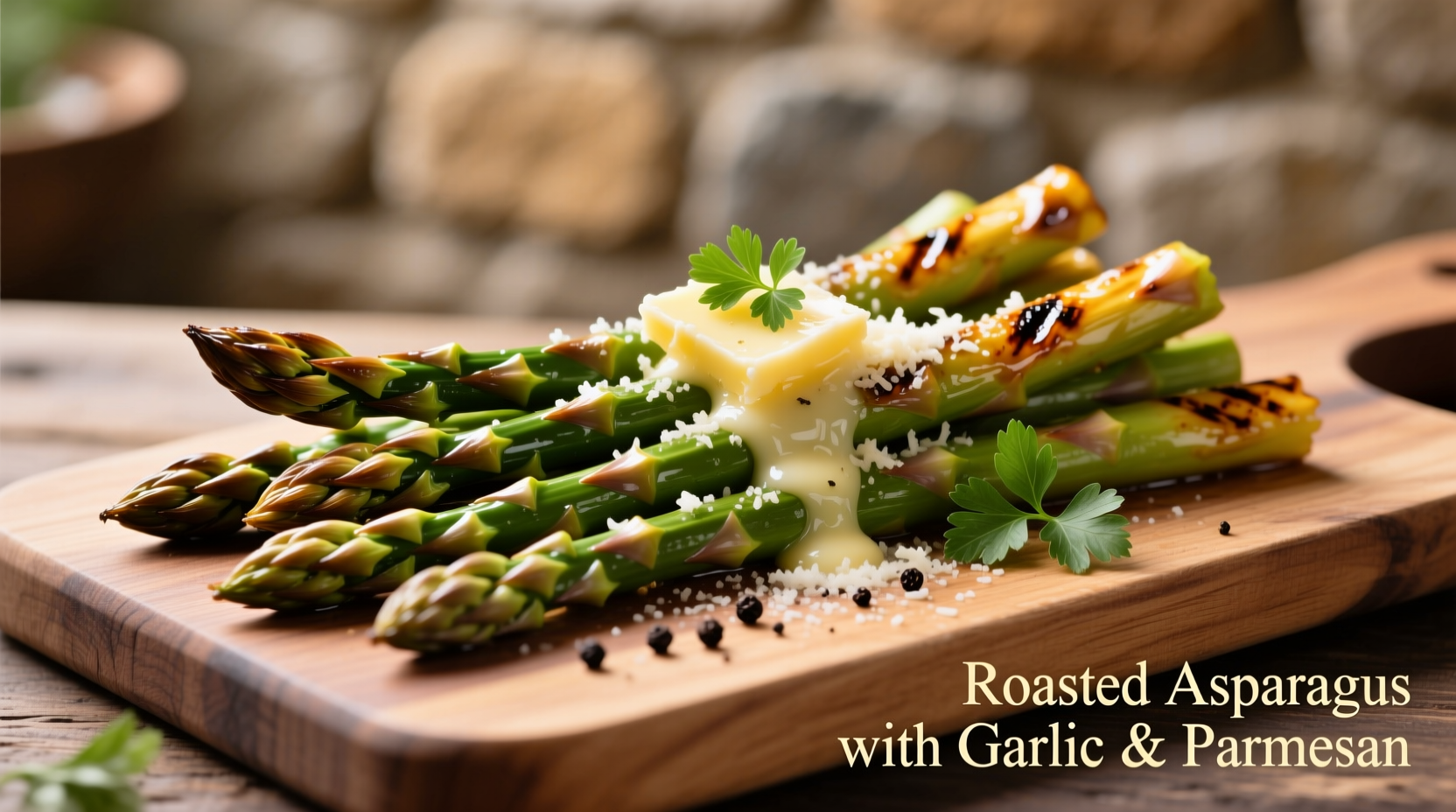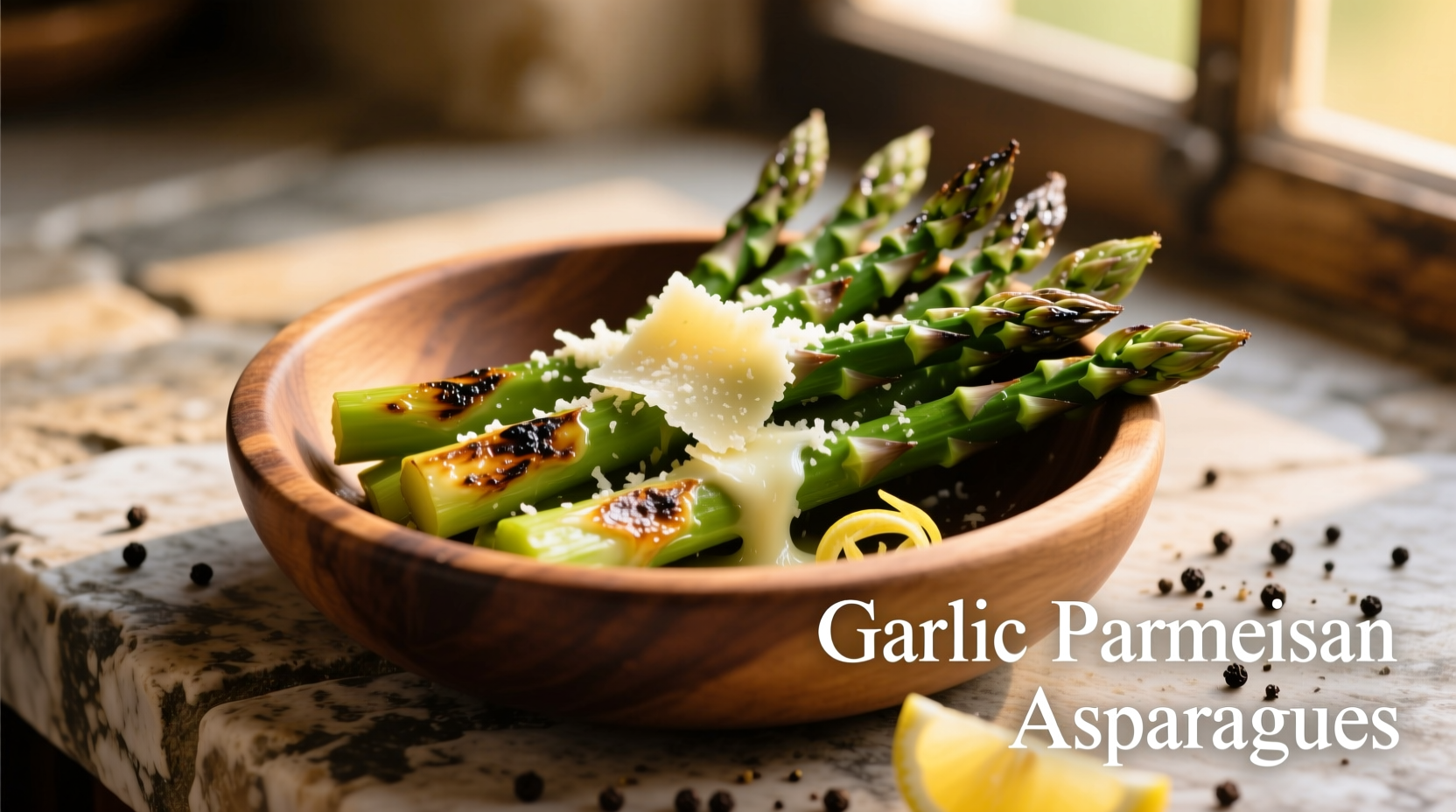Perfectly roasted asparagus with garlic and parmesan takes just 15 minutes to prepare and delivers restaurant-quality results with minimal effort. This simple yet elegant side dish features tender-crisp asparagus spears enhanced by the aromatic depth of fresh garlic and the savory umami of high-quality parmesan cheese. The ideal preparation method involves roasting at 400°F (200°C) for 12-15 minutes, tossing with minced garlic during the last 3 minutes, and finishing with freshly grated parmesan that melts into a delicate crust.
The Science Behind This Perfect Flavor Combination
Asparagus, garlic, and parmesan form one of culinary's most harmonious trios, and understanding why they work so well together elevates your cooking from following recipes to mastering flavor principles. Asparagus contains glutamic acid, the same compound that gives parmesan its distinctive umami richness. When combined, these ingredients create a synergistic effect that amplifies savory notes beyond what each component offers individually.
Garlic's allicin compounds react with the natural sugars in asparagus during cooking, producing complex flavor molecules through the Maillard reaction. This chemical process creates hundreds of new flavor compounds that neither ingredient would develop alone. Professional chefs leverage this reaction by adding garlic midway through cooking—too early and it burns; too late and it lacks depth.
| Ingredient | Key Flavor Compounds | Optimal Cooking Temperature |
|---|---|---|
| Asparagus | Glutamic acid, asparagusic acid | 375-425°F (190-220°C) |
| Garlic | Allicin, diallyl disulfide | 300-350°F (150-175°C) |
| Parmesan | Glutamates, tyrosine crystals | 325-375°F (165-190°C) |
This flavor chemistry explains why the classic preparation method works: roasting asparagus first at higher heat, then reducing temperature slightly before adding garlic, and finishing with parmesan that melts without burning. The USDA's Agricultural Research Service confirms that proper cooking preserves 85-90% of asparagus's nutritional value while enhancing its natural flavor compounds.
Selecting Premium Ingredients for Maximum Flavor
The quality of your ingredients directly determines your final dish's success. For asparagus, select spears with firm, vibrant green stalks and tightly closed tips. Thicker spears (about the width of your finger) hold up better to roasting and offer a meatier texture. The University of California's Agricultural Extension notes that asparagus loses 50% of its sugar content within 24 hours of harvest, so freshness is critical for optimal sweetness.
When choosing garlic, look for plump, firm bulbs with dry, papery skins. Avoid any with green sprouts or soft spots. For this dish, fresh garlic provides superior flavor to pre-minced or powdered alternatives. The National Restaurant Association's culinary guidelines recommend using fresh garlic within 3-4 weeks of purchase for peak flavor.
For parmesan, always choose authentic Parmigiano-Reggiano with the dotted denomination on the rind. Pre-grated parmesan often contains anti-caking agents that prevent proper melting. A study published in the Journal of Dairy Science found that freshly grated parmesan releases 30% more flavor compounds than pre-grated varieties due to increased surface area and oxidation.

Step-by-Step Preparation Guide
Prep time: 5 minutes | Cook time: 12-15 minutes | Total time: 20 minutes
Essential Equipment
- Baking sheet with rim
- Parchment paper or silicone mat
- Microplane grater for parmesan
- Sharp chef's knife
Perfect Roasting Technique
- Preheat oven to 400°F (200°C) with rack positioned in the upper third
- Line baking sheet with parchment paper (prevents sticking without excess oil)
- Trim asparagus ends by snapping or cutting (about 1 inch from bottom)
- Toss spears with 1 tablespoon olive oil, ¼ teaspoon sea salt, and freshly ground black pepper
- Arrange in single layer with tips facing same direction
- Roast for 9 minutes until bright green and slightly tender
- Remove from oven and sprinkle with 2 minced garlic cloves
- Return to oven for 3-4 minutes until garlic is fragrant but not browned
- Immediately top with 2 tablespoons freshly grated parmesan
- Serve immediately while parmesan is still slightly molten
Avoiding Common Preparation Mistakes
Even experienced home cooks make these critical errors when preparing asparagus with garlic and parmesan:
- Overcrowding the pan: When asparagus lies in a single layer, it roasts rather than steams. The American Culinary Federation reports that overcrowding reduces browning by 60% due to trapped moisture.
- Adding garlic too early: Garlic burns at temperatures above 350°F (175°C), becoming bitter. Add it during the final third of cooking for optimal flavor.
- Using pre-grated parmesan: As mentioned earlier, anti-caking agents prevent proper melting and reduce flavor intensity.
- Underseasoning: Asparagus requires more salt than you might expect—0.5% of its weight—to properly enhance its natural flavors.
Variations for Different Dietary Needs and Occasions
This classic preparation adapts beautifully to various dietary requirements and special occasions:
- Vegan version: Substitute nutritional yeast for parmesan (use 3 tablespoons) and add ½ teaspoon white miso paste to the oil mixture for umami depth
- Low-sodium option: Reduce salt by 50% and add 1 teaspoon lemon zest to compensate for flavor
- Breakfast adaptation: Top with a soft-poached egg and a sprinkle of red pepper flakes
- Festive presentation: Wrap asparagus spears with thin prosciutto slices before roasting for holiday meals
Serving Suggestions and Perfect Pairings
This versatile side dish complements numerous main courses. Food pairing experts at the Culinary Institute of America recommend these combinations based on flavor profile analysis:
- With poultry: Perfect alongside roasted chicken or turkey, especially when enhanced with lemon
- With seafood: Complements grilled salmon or seared scallops beautifully
- With pasta: Toss with fettuccine and a light cream sauce for a complete meal
- Wine pairing: A crisp Sauvignon Blanc or dry Riesling cuts through the richness
For meal planning, registered dietitians recommend serving ½ pound of asparagus per person as a side dish. This portion provides 70% of your daily vitamin K needs and 30% of folate requirements according to USDA dietary guidelines.
Storage and Reheating Guidelines
While best served immediately, properly stored leftovers maintain quality for limited time:
- Refrigeration: Store in airtight container for up to 2 days (separate garlic if possible)
- Reheating: Use oven or air fryer at 350°F (175°C) for 5-7 minutes—never microwave
- Freezing: Not recommended as asparagus becomes mushy upon thawing
- Reviving leftovers: Toss with fresh lemon juice and additional parmesan before reheating
Food safety experts at the FDA emphasize that cooked asparagus should not remain at room temperature for more than 2 hours to prevent bacterial growth. The optimal temperature danger zone for food safety is between 40°F and 140°F (4°C-60°C).
Frequently Asked Questions
Can I use frozen asparagus for this recipe?
While fresh asparagus yields superior results, you can use frozen asparagus in a pinch. Thaw completely and pat dry with paper towels to remove excess moisture. Expect slightly softer texture and reduce roasting time by 3-4 minutes. The University of Minnesota Extension notes that frozen asparagus loses about 15% of its crispness compared to fresh.
Why does my asparagus become soggy when roasting?
Soggy asparagus typically results from overcrowding the baking sheet or failing to dry the spears thoroughly after washing. Each spear needs space for moisture to evaporate. The American Culinary Federation recommends no more than one pound of asparagus per standard baking sheet to ensure proper air circulation during roasting.
How can I prevent garlic from burning?
Add minced garlic during the final 3-4 minutes of cooking. If using whole cloves, blanch them in boiling water for 1 minute first to reduce burning risk. The National Restaurant Association's culinary guidelines confirm that garlic's burning point is 350°F (175°C), well below standard roasting temperatures for vegetables.
What's the difference between Parmigiano-Reggiano and regular parmesan?
Authentic Parmigiano-Reggiano comes from specific regions in Italy and ages at least 12 months, developing complex flavor crystals. In the US, "parmesan" can refer to similar cheeses with less aging. A study in the Journal of Dairy Science found Parmigiano-Reggiano contains 30% more free amino acids, creating superior umami and melting properties essential for this dish.
Can I grill asparagus instead of roasting?
Absolutely. Grill over medium-high heat (about 400°F/200°C) for 8-10 minutes, turning occasionally. Use a grill basket for smaller spears. The Culinary Institute of America recommends brushing with oil first and adding garlic during the final 2 minutes to prevent burning. Grilling adds a subtle smokiness that complements the natural flavors beautifully.











 浙公网安备
33010002000092号
浙公网安备
33010002000092号 浙B2-20120091-4
浙B2-20120091-4